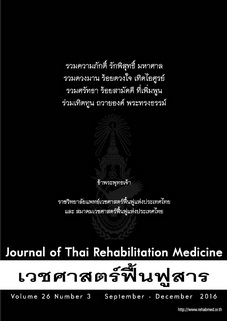ผลของการใส่อุปกรณ์พยุงอุ้งเท้าด้านในและอุปกรณ์พยุงส้นเท้า ชนิดทำจากซิลิโคนต่อแรงกดใต้ส้นเท้า
ผลของการใส่อุปกรณ์พยุงอุ้งเท้าด้านในและอุปกรณ์พยุงส้นเท้า ชนิดทำจากซิลิโคนต่อแรงกดใต้ส้นเท้า
Keywords:
plantar foot pressure, custom-molded medial arch support, custom-molded heel cushion, siliconeAbstract
Objective: To compare plantar hindfoot pressure before and during application of the silicone medial arch supports and the silicone heel cushions in standing.
Study design: Cross-over design
Setting: Department of Rehabilitation Medicine, Siriraj Hospital
Subjects: Thirty volunteers were recruited into the study.
Methods: The medial arch supports and the heel cushions were custom-made by foot impression technique, and were fabricated from silicone (hardness 23o shore A). The plantar hindfoot pressures was measured by digital foot scan machine (FSA Insole®), and compared before and during application of each of the orthoses in standing. The volunteers were divided into 2 groups of 15 by randomization. The first group used the medial arch supports, while the second group wore the heel cushions. After 2 weeks of use, each group was switched to the other type of orthoses for another 2 weeks. After using both orthoses, the researcher evaluated durability of each orthoses and looked for complications of use. The volunteers graded their satisfaction and selected the most preferred one.
Results: When compared with not using any orthoses, both orthoses significantly decreased plantar hindfoot pressure (p ≤ 0.001). When comparing between the medial arch supports and the heel cushions, the medial arch design significantly decreased plantar hindfoot pressure better than with the heel cushion design (p ≤ 0.001). Regarding durability, both orthoses were in good condition after being use for 2 weeks. The level of satisfaction was graded as high in most subjects and there was no complication of using both orthoses.
Conclusion: Applications of both custom silicone medial arch supports and heel cushions can decrease plantar hindfoot pressure in standing. In comparison, the medial arch support design can decrease the pressure better than with the heel cushion design.
References
2. Novak P, Burger H, Tomsic M. Influence of foot orthoses on plantar pressures, foot pain and walking ability of rheumatoid arthritis patients-a randomised controlled study. Disability and Rehabilitation 2009; 31: 638–45.
3. Roos E, Engstrom M, Soderberg B. Foot orthoses for the treatment of plantar fasciitis. Foot & Ankle International 2006; 90:475-9.
4. Hawke F, Burns J, Radford JA, du Toit V. Custom-made foot orthoses for the treatment of foot pain. Cochrane Database Syst Rev 2008; 3:56-9.
5. Buchbinder R. Plantar fasciitis: clinical practice. N Engl J Med 2004; 350:2159-66.
6. Young CC, Rutherford DS, Niedfeldt MW. Treatment of plantar fasciitis. AmFam Physician 2001;63:467-75.
7. Singh D, Angel J, Bentley G. Trevino SG. Fortnightly review: plantar fasciitis. BMJ 1997; 315:172-5.
8. Thammawijaya A, Assawapalangchai Santi . The Study of the effects of medial arch support made from silicone in patients with plantar fasciitis. J Thai Rebabil Med 2013; 23:87-93.
9. Chia JKK, Suresh S, Kuah A, Ong JLJ, Phua JMT, Seah AL. Comparative trial of the foot pressure patterns between corrective orthotics, formthotics, bone spur pads and flat insoles in patients with chronic plantar fasciitis. Ann Acad Med Singapore 2009; 38:869-75.
10. Lunen BV, Cortes N, Andrus T, Walker M, Pasquale M, Onate J. Immediate effects of a heel-pain orthosis and an augmented low-dye taping on plantar pressures and painin subjects with plantar fasciitis. Clin J Sport Med 2011; 21:
474–9.






